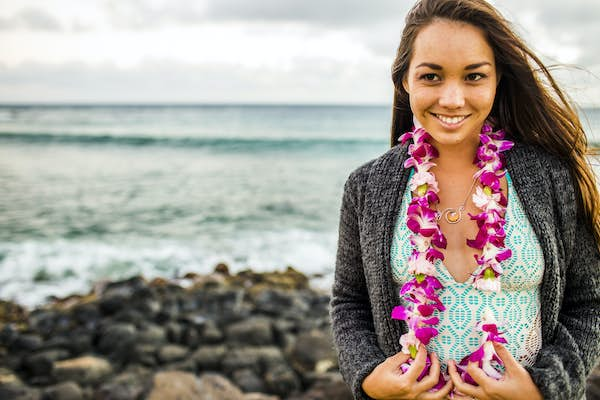You’ll see lei at birthdays, weddings, graduation parties, luau, even at the airport when you arrive. Defined as a garland or wreath, lei is so much more than just a beautiful adornment. In Hawai’i, it’s the symbol of aloha, it’s something you give to someone you love, it’s a way of showing appreciation – a welcome.
The first time I remember wearing a lei was when I graduated from kindergarten. It’s customary in Hawai’i to drape lei — as many as possible! — on graduates, even as young as preschoolers.
It’s not uncommon to see high school seniors decked in dozens of lei stacked so high on their shoulders you can barely see their faces. I wore a fragrant triple-strand white pīkake (jasmine) lei at my wedding and a haku (braided lei for your head) on my 40th birthday — one from my mom, the other from my husband.
Lei is everywhere in Hawai’i — and most travelers will encounter it as soon as they arrive in the Islands. Many hotels will greet their guests with lei as soon as they enter the lobby. There are lei stands at the airport, lei shops in Chinatown and most supermarkets and convenience stores, including 7-Eleven, sell lei.
History of Lei
The stringing of flowers into ceremonial garlands has taken place for centuries in Asia. Early Polynesian voyagers who arrived on the Hawaiian Islands from Tahiti as early as the 5th century brought their lei customs with them.
Over time, Indigenous Hawaiians developed their own unique traditions found nowhere else in the world. In the early days of Hawai’i, lei was created as an adornment and made mostly from flowers, leaves, ferns, seeds, nuts, shells and bright feathers for sacred ceremonies, in hula and on special occasions.
Today, you can find lei made out of candy, ribbon and origami-folded dollar bills. (Locals don’t wear plastic flower lei.)
Lei’s popularity with tourists and celebrities
During the 1900s, tourism to Hawai’i started to grow, and lei greeters lined the pier at Aloha Tower on Oʻahu to welcome visitors disembarking from ships with strands of lei. When the visitors left the Islands, some tossed the lei into the ocean as the ship passed Lēʻahi — or Diamond Head — hoping for a quick return.
In 1961, American crooner Elvis Presley famously wore a yellow-and-white plumeria lei to promote the movie Blue Hawaii. He donned a red and…
Click Here to Read the Full Original Article at Stories – Lonely Planet…
